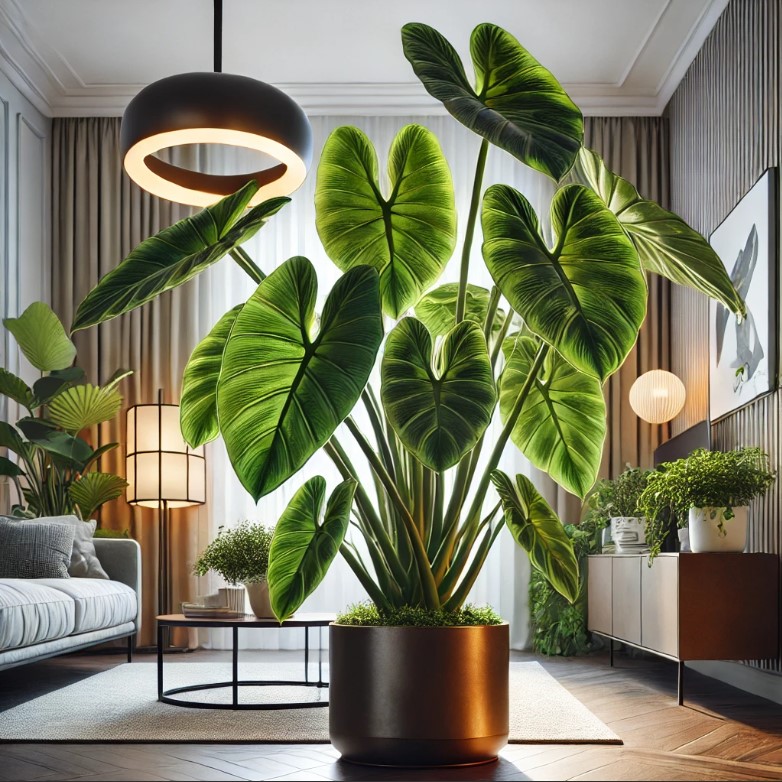Alocasia Macrorrhiza, commonly known as the Giant Taro or Elephant Ear, is a bold and dramatic plant for your indoor garden. With its shiny, oversized, heart-shaped foliage and unusual look, it has a special place in the home of plant lovers. Alocasia Macrorrhiza is a stunner, both out there and exotic adding the perfect height to any home decor. In this article, we will explore the details pertaining to this phenomenal plant, its needs in order to thrive and how you can have one for yourself.
1. What is Alocasia Macrorrhiza?
Alocasia Macrorrhiza belongs to Araceae family and is a native to Southeast Asia. Commonly recognized for its elephant-ear leaves, some measure a few feet long, bringing a theatrical touch to the right room.
2. What Makes Alocasia Macrorrhiza Ideal for Indoors?
This plant will give your home a bold, tropical appearance. For plant lovers it is a great plant as it adds class and earthiness at the same time with its large leaves.
3. How to Care for Alocasia Macrorrhiza
Care for your Alocasia Macrorrhiza to keep it healthy:
Watering — Alocasia Macrorrhiza likes the soil to stay pretty consistently wet. Do not allow the plant to sit in water.
Bright, indirect light is best for this plant. Never expose it to direct sunlight which can burn its leaves.
Temperature: This is a warm plant, so it should stay in the 65-75°F (18-24°C) range.
4. Soil to Use for Alocasia Macrorrhiza
Alocasia Macrorrhiza requires rich potting soil with good drainage. They need a medium that accomodates good drainage, so peat moss + perlite + normal potting soil works great.
5. Watering Alocasia Macrorrhiza
Too much water or too little, both can have negative effects. Water the plant when the soil feels dry within an inch, and make sure that the water does not stand in a pot. Container should be well drainage respectively.
6. Repotting Alocasia Macrorrhiza
While the plant matures, re-potting might also be necessary for accommodating its growing root system. That reads at the time when the roots have results spilling out of their pot it is high time they dig up a new container. Select a container that is 1-2 inches bigger than the existing one.
7. Managing With Common Pests and Diseases
Aphids, spider mites, and some other pests may plague Alocasia Macrorrhiza. Inspect the leaves regularly, and do organic pest management whenever it is needed. Yellowing leaves may signal a pest problem or possibly your watering schedule.
8. How to Fertilize Alocasia Macrorrhiza
During the growing season, give your plant a balanced, water-soluble fertilizer every 4-6 weeks. During the inactive period of winter, cut back on feeding only.
9. How to Propagate Alocasia Macrorrhiza
Propagating Alocasia Macrorrhiza through division To repot, simply split the plant into smaller sections so that each is held together with a good root mass – and plant each section in its own pot.
10. Once again, Alocasia Macrorrhiza in another room
You can put this plant in a restroom or kitchen since they’re both high humidity environments and would replicate what you would typically find in its natural environment. If the air-conditions are dry, then use a humdifir or mist it often.
11. How to Tell Your Alocasia Macrorrhiza is Not Happy
Look out for wilted leaves, discoloration, or insufficient growth. These are the symptoms that your plant might be in some stress. Decrease water, light or humidity levels if needed.
12. Where to Put Alocasia Macrorrhiza the Best Indoor
Alocasia Macrorrhiza likes to stay warm and bright sorcerer, but avoid direct sunlight. Somewhere with filtered light, away from direct solar radiation, such as a location close to a window.
13. Are Alocasia Macrorrhiza Toxic to Pets?
Alocasia Macrorrhiza is a lovely plant but poisonous to kittens and puppies alike. Watch out if you have animals that might eat your plants.
14. Reasons Why You Should Have Alocasia Macrorrhiza in Your House
In addition to its beauty, the Alocasia Macrorrhiza also rids your home of harmful toxins in the air.
15. How To Buy Yourself An Alocasia Macrorrhiza
Alocasia Macrorrhiza Alocasia Macrorrhiza are readily available at specialty plant stores and online plant retailers. Always be certain of the condition of these plants that you are about to buy and even when there are some sellers having low-quality and unhealthy plants will definitely ripe of your money only so go out and search for an authentic seller who can offer you a quality, healthy plant.
Conclusion:
And so Alocasia Macrorrhiza has the potential to increase the exaltation of your indoor garden. This plant has much more to offer and will continue growing nicely at your home as long as you give it the right care! With these care tips followed, you can then enjoy your Alocasia Macrorrhiza growing beautifully.Alocasia Macrorrhiza belongs to Araceae family and is a native to Southeast Asia. Commonly recognized for its elephant-ear leaves, some measure a few feet long, bringing a theatrical touch to the right room.
